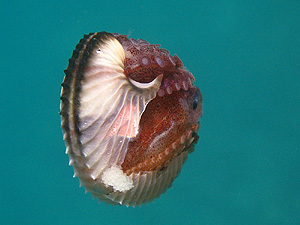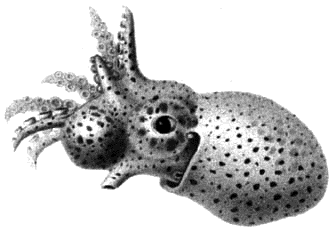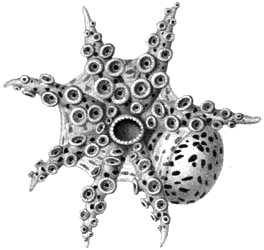Class: Cephalopoda
![]() Subclass: Coleoidea
Subclass: Coleoidea
![]() Superorder: Octopodiformes
Superorder: Octopodiformes
![]() Order: Octopoda
Order: Octopoda
![]() Suborder: Incirrina
Suborder: Incirrina
![]() Tribus: Argonautida
Tribus: Argonautida
![]() Family: Argonautidae
Family: Argonautidae
 Paper Nautilus (Argonauta argo). Picture: Bernd Hofmann, Wikipedia. |
Though the argonaut is called paper nautilus, it is neither made from paper nor is it a nautilus. It not even is closely related to the nautilus, though both are cephalopods.
The argonaut's shell is special among all molluscs. It is only built by the female, and only as case for the protection of the argonaut's eggs, that are placed inside in long threads. The female argonaut lives in the shell's entry and guards the eggs, until the young hatch. At the ends of the first tentacle pair the argonaut (argonauts like other octopus relatives have eight tentacles) has got wide sail-like flaps. Usually the female argonaut holds these flaps spread over the shell, but they also serve it to catch prey that swims into them.

 Immature male argonaut. Picture: Chung 1910. |
Generally living argonauts are difficult to find, possibly because of their pelagic way of life. Much more often their shells, sometimes, masses of them, are deposed on the shore by the sea. That way they also find their way into collectors' packs.
The scientific name of the paper nautilus, especially the largest species, Argonauta argo, is of mythical Greek origin. The argonauts were a group of Greek heroes that, led by Iason, travelled to Kolchis to gain the golden fleece. The were called that way, because their ship was the Argo. In Greek argonaut means "who travels on the Argo". The argonaut's discoverers probably mistook its sail-like flaps as a locomotive organ and thus drew the similarity to the mythical Argo.